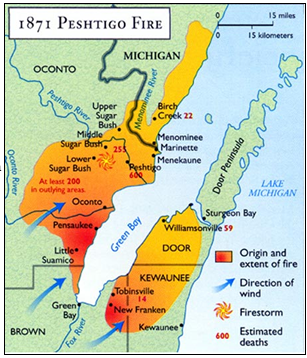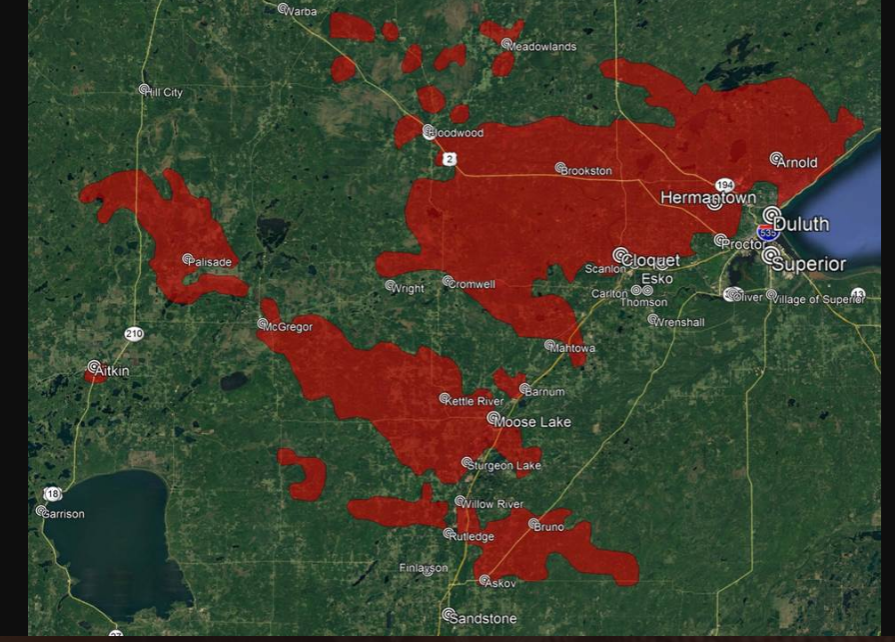The Camp Fire in Northern California is the deadliest wildfire in the United States in a century, according to wildfire historians.
The death toll for the blaze, which is still burning through the foothills of the Sierra Nevada mountains outside Sacramento, increased to 48 Tuesday night as crews searched for bodies in communities that were caught in the fast-moving flames.
The Camp Fire already became the deadliest fire in California history earlier this week – surpassing the 1933 Griffith Park Fire in Los Angeles, which killed 29. It also surpassed the 2013 Yarnell Hill Fire, which killed 19 members of the Granite Mountain Hotshots firefighting crew.
Not since the Cloquet Fire in 1918 has a wildfire killed so many people in the United States. An estimated 450 died in the wildfire in Minnesota. The deadliest fire in U.S. history was the Peshtigo Fire in Wisconsin in 1871. At least 1,200 people died.
The grim milestone of the Camp Fire is the result of increasing development in fire-prone areas and climate change that makes wildfires more intense, experts say.
John Bailey, a wildfire expert and professor at Oregon State University, fears these factors could result in wildfires regularly returning to levels of destruction not seen since before the advent of modern firefighting and prevention.
“We’re returning to levels of fire that were present before the era of effective fire suppression in the 1960s and 70s. Not only did we have good technology and a workforce for fire suppression and a willingness to spend the money – including the Smokey Bear campaign and Walt Disney – it was a real mission of the land management agencies for quite a while,” he says.
Climate change has also caused fire seasons – periods of hot, dry weather that create conditions for wildfires to spark and spread – to grown months longer in many places, Bailey says.
“California barely talks about fire season anymore; it’s [just] part of the year now. Conditions are often worse. We’re reworking conceptualization of how bad they can be.”
Wildfires are not new in the United States. In fact, 150 years ago there were probably just as many wildfires as there are today, says Adam Sowards, a professor of history at the University of Idaho.
But, he says, “we have more people so there is greater likelihood of people getting caught and also as communities build into what fire professionals call wild land urban interface.”
To prevent future deadly fires, it will take major action from governments and people living in fire-prone areas, Sowards says.
“It will take a whole combination of things, from changes in zoning regulations to applying fire back to the landscape in certain context to try to refuel that way,” he says.
“Probably situations where there should be logging in some scenarios, a moratorium on building in some places. Overall we need to pay close attention to the changing climate and what that is doing to our landscape [and] taking that seriously as we plan into the future.”
Here are some of the deadliest wildfires in U.S. history.
Peshtigo Fire – 1871
Peshtigo Fire is the deadliest wildfire in U.S. history. The wildfire burned through 1.2 million acres in Wisconsin, killing 1,200 people. According to the National Weather Service, the blaze began as a brush fire in an unknown part of the Wisconsin forest and that eventually caused $169 million of damage in 17 towns, completely decimating the city of Peshtigo.
The fire was made far worse by a cold front moved in from the west, which brought strong winds of up to 110 mph that fanned the fires. The flames reportedly reached up to 2,000 degrees. The severity of the fire was caused by multiple factors, including prolonged drought, logging and clearing of land for farms.

Cloquet Fire – 1918
In October of 1918, 450 people died in Minnesota’s Cloquet Fire. The wildfire burned through 250,000 acres and caused $73 million in damage. According to the Weather Service, a spark from a passing train mixed with the parched landscape and winds of up to 76 mph led to the worst wildfire in Minnesota history – and one of the worst in the recorded U.S. history. At the time, northeast Minnesota was reportedly experiencing its driest season in 48 years.
In the end, 38 communities were destroyed by the blaze, including Cloquet, Moose Lake and Kettle River.

The Great Fire- 1910
The Great Fire of 1910 burned through 3 million acres in northern Idaho and western Montana. According to the Forest History Society, the wildfire killed 87 people, mostly firefighters, and is believed to be the largest wildfire in U.S. history. Although no official cause was determined, throughout the dry summer up to 100 small fires in the areas were started by railroad sparks. That August, strong winds swept through the area and fanned embers causing flames to spread rapidly.
In what is known as the “Big Blowup,” the fire continued to spread rapidly for two days before it was stopped by rain.
According to the Weather Service, the smoke for the Great Fire spread a third of the way around the world – producing some dark days in the U.S. and Canada.
Griffith Park Fire- 1933
In 1933 the Griffith Park Fire in Los Angeles, Calif., 29 firefighters died trying to put out the blaze that started as a brush fire that spread up the Mineral Wells Canyon and burned through 47 acres. The Griffith Park Fire was the deadliest wildfire in California history until 2018’s Camp Fire.
Yarnell Hill Fire – 2013
The 2013 Yarnell Hill Fire in Arizona burned though 8,400 acres and killed 19 members of the Granite Mountain Hotshots, a group within the Prescott Fire Department whose mission was to fight wildfires. The wildfire was sparked by lightning and spread by 22 mph winds and extremely dry conditions caused by a drought. The wildfire ultimately caused $664 million in damage and was the deadliest wildfire in Arizona history.
Cedar Fire- 2003
In 2003, the Cedar Fire in San Diego burned through 273,246 acres, killing 15 people, including one firefighter. The blaze caused over a $1 billion in destruction and began in the Cleveland National Forest by a hunter signaling for help. It quickly spread due to the Santa Ana Winds. The Cedar Fire destroyed nearly 3,000 structures, including 2,232 homes.
More Must-Reads from TIME
- Caitlin Clark Is TIME's 2024 Athlete of the Year
- Where Trump 2.0 Will Differ From 1.0
- Is Intermittent Fasting Good or Bad for You?
- The 100 Must-Read Books of 2024
- Column: If Optimism Feels Ridiculous Now, Try Hope
- The Future of Climate Action Is Trade Policy
- FX’s Say Nothing Is the Must-Watch Political Thriller of 2024
- Merle Bombardieri Is Helping People Make the Baby Decision
Write to Gina Martinez at gina.martinez@time.com